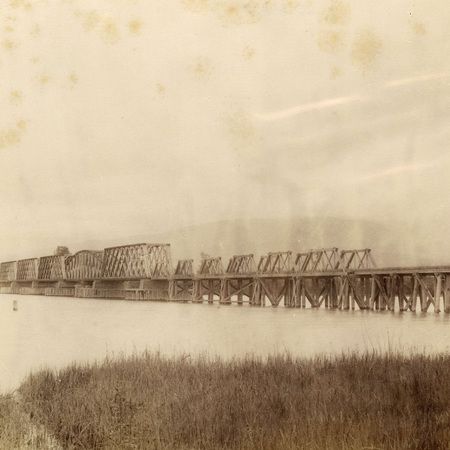
 604 465 4322
604 465 4322General Store Site 12294 Harris Road Pitt Meadows, B.C.
Click Here for Directions& Visiting Hours

Looking Back: 1867 to 1885
Looking back article from January 2017.
*The image features the Pitt River Bridge - C.P.R. Railway - 7 miles above Port Moody c. 1880's
The pivotal event during this period is the establishment of the Dominion of Canada on July 1st, 1867. The BNA Act had actually been signed on May 8th but came into effect on the date we now call Canada Day. John A. MacDonald, who helped draft the Act, was appointed Prime Minister of the new country and would be elected to the position in August. The founding four – Ontario, Quebec, Nova Scotia and New Brunswick.
Meanwhile, out west gold had been discovered in the Fraser Canyon in 1858 and the British government, to keep American incursions at bay, established the colony of British Columbia, and surveyed much of what is now the lower mainland. Pitt Meadows appears on maps soon after and the first land grant in the area is given in 1859 to a Charles Good. By 1867 two further land grants had been given, only one of which was actively farmed. This is also the period when the Colonial Government introduced its first Land Act and established a reserve system forcing aboriginal people (then called Indians) on to land “reserved” for them, Katzie included.
By 1871 the Dominion Government faced its first major obstacle -- Louis Riel and the Red River Rebellion. Out west British Columbia was preparing to join confederation, and did so on July 20th. In Pitt Meadows land grants continued through 1873 and then stop through to 1887. A land grant for the site our very own Hoffmann and Son building now sits on was given in 1871, the first owner being John McKenney who would become Reeve of Maple Ridge in 1879.
A few years later, in 1874, Wellington Jeffers Harris, along with his wife Mary Jane and son Frank, arrived in Pitt Meadows and acquired considerable acreage in what we now call the highland area, including the property on the east side of what is now Harris Road to both the north and south of what would eventually become the CPR corridor. The building that is the Museum would eventually occupy some of that land. Folklore tells us Harris, while still a young man in Ontario, had heard of Pitt Meadows and the possibility of a railway from Simon Fraser, who had retired to farmland near Harris’ family. The Pacific Line of said railway would begin in 1876 and be renamed the Canadian Pacific in 1879. The stretch through Pitt Meadows, and the completion of the railway overall, would take place in 1885 with the first train from the east passing through in November of that year. The “Fraser Valley Local” daily run would be established in 1886, bringing about the demise of river boats to the area. 1874 is also the year the Municipality of Maple Ridge incorporates and Pitt Meadows is a part of this incorporation with Mr. Harris, a Pitt Meadows resident, as its first Reeve/Warden.
Eighteen year’s post confederation John A. was again our Prime Minister, the Dominion Government had dealt again with that thorn in their side, Louis Riel and the North West Rebellion, and put him to death in November 1885. The young country had female doctors, a completed transcontinental railway, its first national park (Banff),tariffs to protect Canadian trade goods, its first university (Manitoba),the North West Mounted Police, the Indian Act and reserves, seven provinces and one territory, and a population of approximately 4,325,000. Pitt Meadows by that time was still an isolated community with far fewer than 100 residents, a railway connection to Port Moody or points east, George Howison as Reeve of the entire area, and an aboriginal population now contained on a reserve. There were farms and settlers with names such as Harris, Cook, Richardson and Bonson, but no industry and no schools, churches, shops, etc. In March we will look at the years 1886 through 1905.
Leslie Norman, Curator at the Pitt Meadows Museum





